
The Inventory Management Templates are professionally designed, pre-formatted spreadsheets available in Excel, Google Sheets, and Open Office Calc formats. These templates are specifically crafted to streamline the process of inventory management and tracking.
These comprehensive tools maintain meticulous records of products acquired and sold by a business entity. They encompass crucial data points, including but not limited to, current stock quantities, unit pricing, and stock valuation. Moreover, these templates provide additional functionalities that enable businesses to monitor inventory turnover rates and calculate average inventory levels over specified periods.
Furthermore, these templates incorporate sophisticated algorithms to perform essential inventory cost calculations. Such calculations are integral to the preparation of accurate Profit and Loss Statements during the financial accounting process. The templates also offer the capability to generate detailed inventory reports, which can be customized to meet specific business requirements.
Additionally, the templates enable users to ascertain precise inventory levels for each product in real-time. Users have the option to specify reorder quantities, thereby activating an automated alert system within the template. This system efficiently highlights products that require replenishment, thus minimizing the risk of stockouts and potential loss of sales.
By utilizing these advanced inventory management templates, users can expeditiously analyze purchasing and sales patterns over specified timeframes. This analytical capability facilitates the identification of top-performing products and allows for data-driven decision-making regarding inventory optimization and product mix strategies.
What is Inventory Management?
Inventory management is a comprehensive process that involves the systematic monitoring and maintenance of the procurement, storage, and sale of goods. The primary objective of this process is to ensure the consistent availability of supply when required, while concurrently minimizing the accumulation of excess or obsolete stock.
This process involves:
- Strategic management of procurement processes.
- Implementation of efficient storage protocols for products.
- Development and execution of effective dispatching and reporting systems.
- Rigorous monitoring of product-wise sales performance.
- In-depth analysis of stock movement patterns and trends.
Typically, small and medium-sized enterprises (SMEs) employ manual stock management tools. These tools are often created using spreadsheet software such as Microsoft Excel, Google Sheets, or Open Office Calc. The utilization of such software allows for customization and flexibility in inventory management practices.
It is important to note that inventory management templates vary significantly across different business types. For instance, the inventory management needs of retailers differ substantially from those of wholesalers, hotels, or real estate businesses. Consequently, templates are often tailored to address the specific requirements of each industry sector.
Importance of Inventory Management
Inventory management plays a pivotal role in the operational efficiency and financial performance of any business entity. Inadequate inventory management can lead to substantial losses, manifesting in various forms such as customer dissatisfaction and the accumulation of obsolete stock. Therefore, it is imperative for businesses to implement effective supply chain management strategies, encompassing all aspects from warehousing to order fulfillment.
Decrease Storage Costs
The storage of excessive inventory inevitably leads to increased product costs and, ultimately, surplus expenses. Effective inventory management aids in the definition and implementation of an optimal ordering system, thereby mitigating unnecessary storage costs. This optimization process may involve the use of just-in-time inventory practices or the implementation of advanced forecasting techniques to align inventory levels with projected demand.
Minimize Losses
The procurement of excessive quantities of products can result in a higher proportion of dead stock, which represents a significant financial burden for businesses. Through diligent inventory tracking, businesses can accurately identify fast-moving products and adjust their purchasing strategies accordingly, thereby mitigating the risk of over-ordering. This approach not only reduces financial losses but also improves overall inventory turnover rates.
Moreover, businesses face potential losses due to internal theft by employees or handling staff. The implementation of rigorous inventory management practices, including regular product recounts and periodic audits, can serve as a deterrent to such activities and minimize associated losses.
Product Availability
In today’s highly competitive market landscape, particularly in the e-commerce sector, ensuring consistent product availability is paramount. The implementation of a robust reordering system, coupled with timely execution, facilitates seamless product availability. This, in turn, enhances customer satisfaction and increases the likelihood of customer acquisition and retention.
Minimize Order Processing Time
For e-commerce businesses, in particular, maintaining expedient order processing times is crucial for success. Effective inventory management practices lead to a significant reduction in processing times, thereby increasing sales potential and improving overall operational efficiency. This can be achieved through the implementation of automated inventory systems and streamlined fulfillment processes.
Manage Multiple Sales Channels
When a business operates across multiple sales portals, maintaining a high level of accuracy in inventory management becomes increasingly complex. Proper inward and outward entry processes facilitate the seamless management of inventory across various sales channels. This approach ensures consistency in product availability and prevents discrepancies that could lead to customer dissatisfaction or lost sales opportunities.
Sales Forecasting
Detailed outward inventory entries enable businesses to identify and analyze sales patterns with greater precision. Furthermore, historical sales data from previous months or years serves as a valuable resource for forecasting future sales trends. This predictive capability allows businesses to optimize their inventory levels and adjust their purchasing strategies proactively.
Customer Satisfaction
The successful execution of orders and timely delivery of products are fundamental to achieving high levels of customer satisfaction.
Effective inventory management plays a crucial role in meeting these objectives, contributing significantly to the development and maintenance of a positive product brand reputation. This, in turn, can lead to increased customer loyalty and positive word-of-mouth marketing.
Inventory Management Templates
This section consists of 3 different Inventory Management Templates for different inventory needs. All these Inventory Management Templates are available in 3 formats: Excel, Google Sheets, and Open Office Calc. Click on the desired icon button to download the respective file format.
Download Stock Inventory Management Template
We have created a simple Stock Inventory Template with predefined formulas and formating. Insert your daily inward and outward stock entry. In addition to that, you can keep an eagle’s eye on your stock as well as helps to increase the profitability of your business.
Inventory Control Template can be useful for all kinds of businesses. All retailers, wholesalers, store managers, and especially e-commerce businesses like Amazon, Flipkart, and Snapdeal vendors, etc and use this template.

Excel Google Sheets Open Office Calc
Click here to Download All Accounting Excel Templates for ₹299.
Important Note: The instructions provided regarding editing and customizing the Google Sheet template are clear. Saving a copy to one’s Google Drive using the “Make a Copy” option from the File menu is necessary to edit and customize the template.
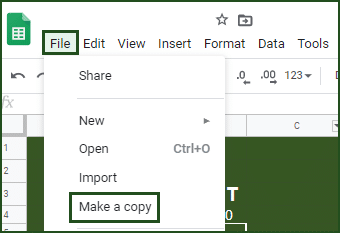
The mention of other Excel-based accounting templates, such as Profit & Loss Account, Accounts Receivable, and Accounts Payable templates, is helpful for users seeking additional financial management tools.
Contents of Stock Inventory Management Template
The design of the Inventory Control Template consists of two sections: the Heading Section and the Inventory Section, as described below.
Heading Section
The first line serves as the heading, “Inventory Control Sheet.” A checkbox is provided next to the heading, which, when selected, will highlight all items requiring reordering.
Other sub-headings for Data input section are as below:

Inventory Section
Inventory Control ID: This field accommodates a unique alphanumeric identifier for each product. For instance, “ABC001” is utilized as an exemplar in the worksheet. This identification system allows for precise tracking of individual items within the inventory.
Product Detail: This field is designated for the product name and description, enabling clear identification of each item in the inventory.
Quantity Purchased: The number of units acquired for each product is recorded in this field, providing a baseline for inventory calculations.
Price/Unit: The cost per unit of each product is entered here, facilitating accurate valuation of the inventory.
Quantity in Stock: This field displays the current quantity available, calculated by subtracting the Quantity Sold from the Quantity Purchased. This real-time update of stock levels is crucial for inventory management.
Value Stock in Hand: The monetary value of the current stock is computed by multiplying the Quantity in Stock by the Price/Unit. This calculation provides an immediate assessment of the inventory’s worth.
Reorder Level: Users must input a threshold value that indicates when a product’s stock falls below a specified limit, necessitating reordering. This proactive approach helps prevent stockouts.
In the Heading Section, a highlight checkbox is there. If you tick that checkbox, the product below the reorder level will be automatically highlighted.
Reorder Quantity: This field allows users to specify the quantity to be reordered. The reorder quantity can be predefined or adjusted based on sales patterns, enabling flexible inventory management strategies.
Quantity Sold: Daily sales figures are entered here, providing an accurate and up-to-date status of each product’s inventory.
Discontinued Product: Users can indicate whether a product has been discontinued by entering “Yes” in this field. This action results in a visual change, applying a strike-through line to the corresponding row, clearly denoting the product’s discontinued status.
See image below for reference:

Users can generate various reports with the help of this template, such as reports for a particular product, stock level, reorder level, and more, by selecting the desired options from the drop-down menus.
Report Generation
The template leverages Excel’s table functionality to enable sophisticated report generation.
Users can produce various reports by utilizing the drop-down menus associated with different sub-headings. This feature allows for the creation of targeted reports based on specific criteria such as product, product ID, amount, or tax.
Download Stock Inventory Management Template With Tax (VAT/GST/Sales Tax)
This template is beneficial for individuals residing in countries where taxes such as GST, VAT, or Sales tax are applicable. A simple and easy-to-use template for Stock Inventory Management with Tax has been created using Excel’s table function and predefined formulas.
Excel Google Sheets Open Office Calc
Contents of Stock Inventory Management Template With Tax
Inventory Management Template consists of 3 sections: Header Section, Inventory Section, and Value of Stock Section.
The contents of this template are the same except the value of the stock section.
Value of Stock Section
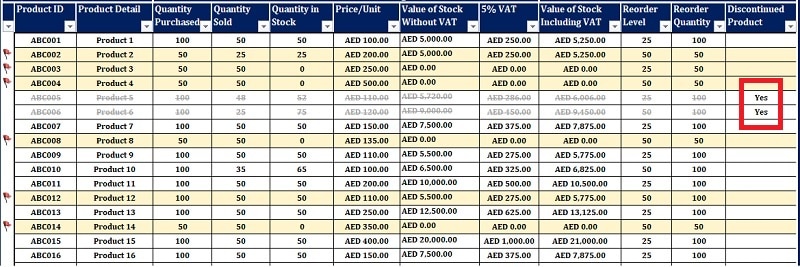
Price/Unit: This field is used to calculate the value of the stock excluding Value Added Tax (VAT).
Value of Stock Without VAT: This value is calculated using the formula: Stock in Hand × Price/Unit.
5% VAT: The VAT amount is computed as 5% of the Value of Stock Without VAT.
Value of Stock Including VAT: The total value is derived by adding the Value of Stock Without VAT and the 5% VAT amount.
Reorder Level: This field functions similarly to its counterpart in the non-tax version, highlighting rows when stock falls below the specified threshold.
Hence, define a level for reordering. It will highlight the row if a product’s stock falls below that limit, indicating the need to reorder the product to prevent unavailability.
As we discussed earlier, there is a checkbox in the header section. If the checkbox is checked, the product below the reorder level will be automatically highlighted.
Reorder Quantity: As in the previous template, this field allows for the specification of reorder quantities based on predefined values or dynamic sales patterns.
Discontinued Product: Sometimes, there are products whose sales have been stopped, and we do not buy them anymore.
It might also happen that it might be a special edition and discontinued by the supplier.
If you enter “yes” against any such product in these cells, it will display a strike-through line upon the values, indicating that the product has been discontinued.
Download Asset Inventory Management Template
We have created a simple and easy Asset inventory and tracker with predefined formulas and formatting that helps you to record more than 500 personal/company assets.
Furthermore, it also consists of a Quick Asset Tracker, where you can search for details of any asset by search the asset by its unique ID.
Excel Google Sheets Open Office Calc
Contents of Asset Inventory Management Template
This template consists of 2 sheets: Asset Inventory and Quick Asset Tracker.
Asset Inventory
This sheet is designed for recording comprehensive details of each company asset. It accommodates both personal and corporate assets.
Personal assets may include additional real estate, commercial properties, and personal equipment. Corporate assets encompass all items purchased for organizational operations, such as office furniture, computers, routers, warehouses, and company vehicles.

At the top of the sheet, enter your company or individual name. Adjacent to this, the total asset value is displayed. This figure updates automatically as you input asset entries with corresponding price details.
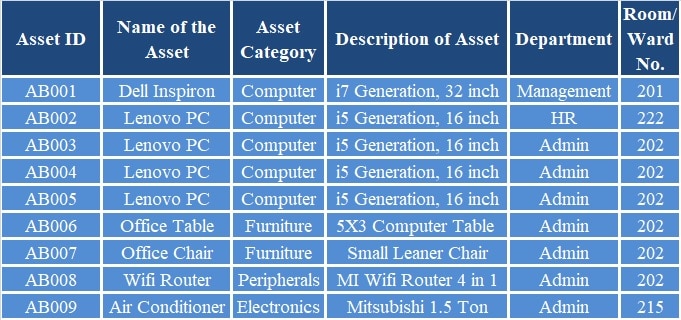
This sheet consists of the following columns:
Asset ID
Name of Asset
Asset Category
Description of Asset
Department
Room/Ward No.
Date of Purchase
Seller’s/Supplier’s Name
Guarantee (in Months)
Warranty (In Months)
Purchase Price
Installation Charges (if applicable)
Total Cost of Asset
Model No.
Serial No
Remarks
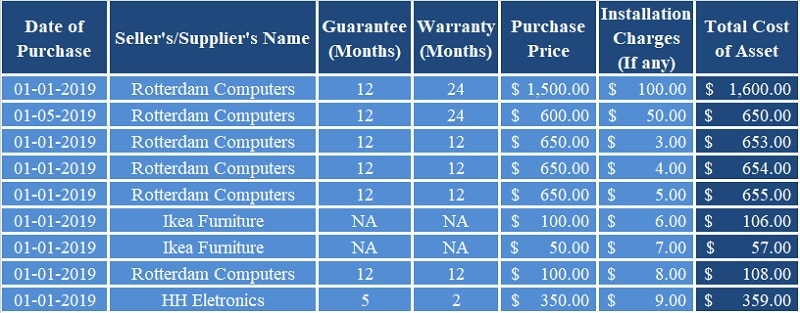
Insert relevant details applicable to your asset in the above-mentioned heads. Add assets as and when you purchase the asset and don’t forget to remove when you discard.
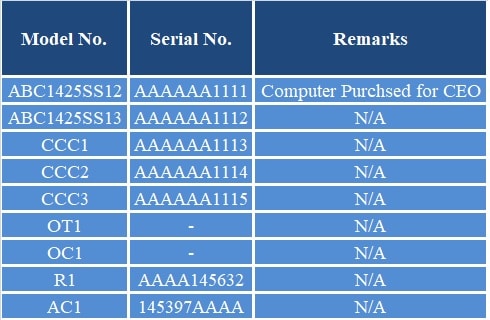
Quick Asset Tracker
As the number of assets grows, locating specific information becomes challenging. To streamline this process, we have developed the Quick Asset Tracker, enabling rapid retrieval of asset details.
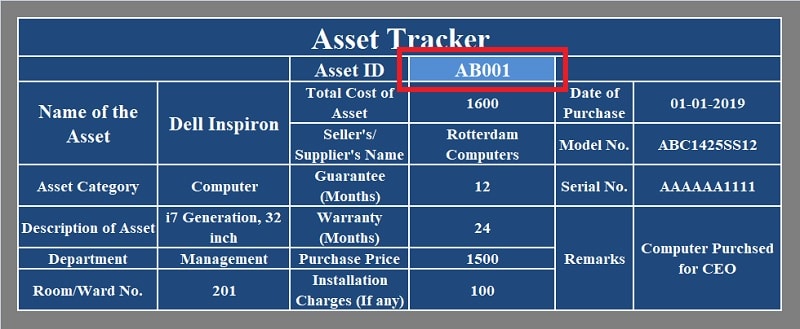
In the Asset Inventory sheet, each asset is assigned a unique ID. To utilize the Quick Asset Tracker, simply enter the asset ID and press enter. The system will automatically retrieve all pertinent information for that specific asset using the VLOOKUP function.
Asset Management Tips
Here some tips that can be helpful in effective asset management:
- Maintain a comprehensive record of all assets, including their respective values.
- Establish a structured process for asset acquisition.
- Conduct thorough needs assessments prior to purchasing requested items.
- Exercise caution when importing data from external systems, and always verify imported information.
- Develop a loss prevention strategy tailored to your specific business operations.
- Make decisions that maximize return on investment (ROI).
- Implement a robust and consistent auditing plan to address unforeseen scenarios.
- Disseminate your asset management strategy across all departments.
- Diversify your Stock Keeping Unit (SKU) attributes.
- Provide comprehensive systems training to staff to ensure proper utilization of equipment and minimize unnecessary damage.
We thank our readers for liking, sharing, and following us on different social media platforms.
If you have any queries or questions, share them in the comments below and I will be more than happy to help you.
More Inventory Management Templates
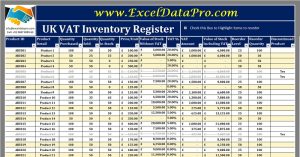
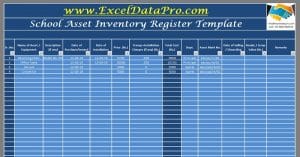
Frequently Asked Questions
What is Cycle Counting in Inventory Management?
Cycle counting is a methodical approach to inventory management that involves counting a subset of inventory items at regular intervals, as opposed to conducting comprehensive annual or quarterly stocktaking. This practice facilitates the prompt identification of erroneous inventory records and aids in the prevention of internal misappropriation. By implementing cycle counting, organizations can maintain more accurate inventory records throughout the year, leading to improved operational efficiency and reduced discrepancies.
What is ABC Analysis in Inventory Management?
ABC analysis is a sophisticated inventory classification technique employed by businesses to prioritize products based on their sales patterns and value. This method categorizes inventory items into different priority levels for cycle counting, typically dividing them into three categories: A (high value), B (medium value), and C (low value). By focusing more attention on high-value items, companies can allocate resources more effectively and optimize their inventory management processes.
What is Inventory Forecasting?
Inventory forecasting is the process of estimating future demand for a product by meticulously analyzing historical sales data and identifying recurring patterns. This crucial practice enables businesses to maintain optimal inventory levels, reduce carrying costs, and minimize the risk of stockouts or overstocking. Accurate forecasting involves considering various factors such as seasonality, market trends, and economic conditions.
What is Economic Order Quantity (EOQ)?
Economic Order Quantity (EOQ) is a calculation method utilized by businesses to determine the optimal quantity to order for purchase, with the primary objective of minimizing unnecessary inventory costs. These costs encompass expenses associated with holding stock, shortages, and order processing. By striking a balance between ordering costs and holding costs, the EOQ model helps organizations optimize their inventory levels and reduce overall inventory-related expenses.
What is the FIFO (First-In, First-Out) Method?
FIFO (First-In, First-Out) is a fundamental principle of product rotation that significantly aids in maintaining product quality and freshness. Under this method, products that are produced or acquired first are sold first, thereby minimizing spoilage and waste. This approach is particularly beneficial for businesses dealing with perishable goods or products with expiration dates, as it ensures that older stock is utilized before newer stock.
What is the LIFO (Last-In, First-Out) Method?
LIFO (Last-In, First-Out) operates in the opposite manner to the FIFO method. In this approach, products that are produced or acquired last are sold first. The primary purpose of this method is to minimize taxable profits by matching current costs with current revenues. However, it is important to note that the LIFO method is not widely accepted by tax authorities in most jurisdictions due to its potential for manipulating reported profits.
What is Opening Stock?
Opening Stock, also referred to as Beginning Inventory, is the inventory available in the inventory account at the commencement of an accounting year or the inception of a business. This figure serves as a crucial starting point for inventory valuation and financial reporting, providing a baseline for calculating the cost of goods sold and ending inventory for the accounting period.
What is Closing Stock?
Closing Stock refers to the inventory on hand at the conclusion of the accounting year or the termination of a business. This figure is essential for accurate financial reporting and inventory valuation. The closing stock of one accounting period becomes the opening stock of the subsequent period, ensuring continuity in inventory tracking and financial statements.